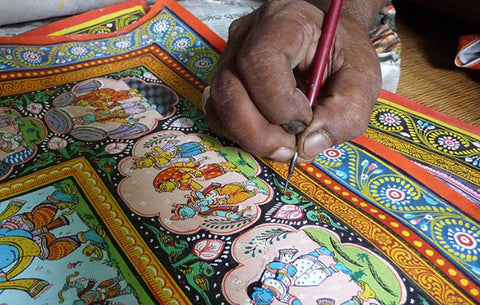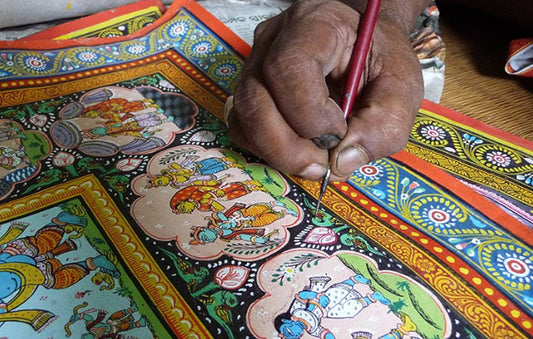Pattachitra paintings are a traditional form of folk art from the state of Odisha in India. These intricate and colorful paintings have a rich history dating back several centuries and are an integral part of Odisha's cultural heritage. Here's a brief overview of the history of Pattachitra paintings:

1. Ancient Origins: The origins of Pattachitra can be traced back to ancient Odisha (formerly known as Kalinga) and are believed to have originated around the 5th century AD. These paintings were traditionally done on cloth, palm leaves, or specially prepared canvas (called "Patta" in Odia, hence the name Pattachitra). They often depicted religious and mythological themes.

2. Religious Significance: Pattachitra paintings have strong ties to the religious traditions of Odisha. They were often created as offerings to the Jagannath Temple in Puri and other temples in the region. Pattachitra artists were considered to be serving the gods through their art, and the paintings played a vital role in temple rituals and festivals.
3. Themes and Subjects: Pattachitra paintings typically depict stories from Hindu epics like the Ramayana, Mahabharata, and Puranas. These paintings also feature scenes from the life of Lord Krishna, Jagannath, and other deities. The artists use vibrant colors, intricate detailing, and traditional iconography to bring these stories to life.
4. Artistic Techniques: Pattachitra artists use natural pigments derived from minerals, shells, and plants, which give the paintings their distinctive colors and longevity. They use fine brushes made from animal hair and create detailed and stylized figures, often characterized by elongated eyes and graceful postures.
5. Regional Variations: While Pattachitra is closely associated with Odisha, there are regional variations within the art form. The two main schools of Pattachitra painting are the "Jagannath Puri" style and the "Raghurajpur" style. The latter is a famous village in Odisha known for its Pattachitra artists and was declared a heritage village.
6. UNESCO Recognition: In 2018, Pattachitra paintings, along with another traditional art form called "Raja Rani Temple murals," were inscribed on UNESCO's Representative List of the Intangible Cultural Heritage of Humanity. This recognition has helped to preserve and promote this ancient art form.
7. Contemporary Relevance: Today, Pattachitra continues to be a vibrant and living tradition. Modern Pattachitra artists are adapting their art to contemporary themes and materials while preserving the traditional techniques and aesthetics. This has helped to keep the art form relevant in the modern world.
Pattachitra paintings are not just artworks but also cultural treasures that have been passed down through generations in Odisha. They serve as a visual link to the rich history and spirituality of the region and continue to be cherished by art enthusiasts and collectors worldwide.



